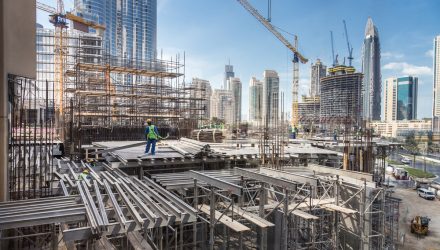The U.S. is great at a lot of things, but infrastructure investment isn’t one of them. The need to change that and change it quickly puts a spotlight on ETFs such as the AGFiQ Global Infrastructure ETF (GLIF).
The AGFiQ Global Infrastructure ETF uses a multi-factor investment process to seek long-term capital appreciation by investing primarily in global equity securities in the infrastructure industry. President Trump is pitching a 10-year, $1 trillion infrastructure plan, which is scaled back from his 2016 campaign trail plan. Indeed, costs play a role in determining the fate of domestic infrastructure efforts.
“There is reason to suspect that high U.S. costs are part of a deeper problem. For example, construction seems to take a lot longer in the U.S. than in other countries,” writes Noah Smith for Bloomberg. “In China, a 30-story building can be completed in only 15 days. In Japan, giant sinkholes get fully repaired in one week. Even in the U.S. of a century ago, construction was pretty fast — the Empire State Building went up in 410 days.”
GLIF: Increasingly Relevant
The infrastructure category has also historically offered higher dividend yields than global fixed-income and global equities, along with greater predictability of long-term cash flows. The ETF may be able to capture the growing demands of economic development that are driving more funding into transport, power, and other systems.
Today “it takes the U.S. many years to spend the money that Congress allocates for infrastructure. New buildings seem to linger half-built for months or years, with construction workers often nowhere to be found,” notes Smith.
The strong, consistent demand for infrastructure has delivered stable, repeatable cash flows to investors. Meanwhile, population growth, aging infrastructure, and constrained government budgets are creating opportunities for the private sector. The high cost of entering the infrastructure business also limits competition or provides a wide economic moat for those already in the field.
With the White House looking to unleash a massive wave of stimulus onto the U.S. economy and in an effort save jobs numbers from sliding, infrastructure could be in style as the coronavirus situation, hopefully, eases soon. Some data points confirm that some of the stimulus packages should be going toward infrastructure.
“The U.S. construction sector is sick, and the disease must be diagnosed. Otherwise, infrastructure debates will continue to seesaw between those who are willing to spend too much and those who are willing to let the system crumble because it costs too much to repair,” opines Smtih.
For more alternative investing ideas, visit our Alternatives Channel.
The opinions and forecasts expressed herein are solely those of Tom Lydon, and may not actually come to pass. Information on this site should not be used or construed as an offer to sell, a solicitation of an offer to buy, or a recommendation for any product.








